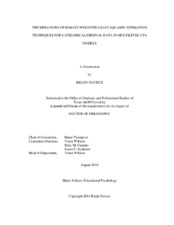| dc.description.abstract | This present Monte Carlo study was conducted to investigate the behaviors of weighted least square mean (WLSM) and weighted least square mean and variance (WLSMV) estimation techniques with categorical/ordinal data in multilevel confirmatory factor analysis (CFA) models under various conditions. Specifically, the study focused on how well WLSM and WLSMV estimation techniques work for multilevel CFA models with categorical/ordinal data by examining parameter estimates, standard error estimates of the parameters, and some of the fit indices. Also, the performance of commonly used fit indices for misspecified two-level CFA models for categorical/ordinal variables with the WLSM and WLSMV estimations was examined using traditional cutoff values for the fit indices.
Simulation results showed that WLSM and WLSMV estimated biased factor pattern coefficients and the factor correlation in the between-level regardless of the simulation design factors. In the within-level model, the factor pattern coefficients and correlation were unbiased when a large number of cluster size (CS) and a large number of clusters (NC) were used; but these parameters were biased when a small NC and CS were used. Standard error estimates of the parameters in both within- and between-levels were biased regardless of the design conditions, so parameters should not be evaluated based on statistical significance test results even when these parameter estimates are unbiased.
The chi-square overall model test statistics were poorly estimated. WLSM or WLSMV based overall model chi-square test statistics did not follow the traditional chi-square test distribution. Because of that, lower power rates were obtained when factor pattern coefficients were misspecified in the between- or within-level models. Generally, CFI, TLI, RMSEA, SRMR for the between-level model (SRMR-B), and SRMR for the within-level model (SRMR-W) performed poorly for detecting misspecifications. As a final remark, it is better not to use robust WLSM or WLSMV estimation techniques in the multilevel CFA models when clustered categorical/ordinal data are present. | en |


